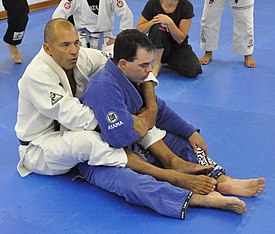Hooks (grappling)
| Hooks | |
|---|---|

Royce Gracie (white gi) demonstrates a secure rear mount with hooks on his opponent.
|
|
| Classification | Grappling |
| Style | Judo, Brazilian Jiu-Jitsu |
| Parent hold | Back Mount |
| Child hold(s) | Body triangle |
Hooks is a term in grappling martial arts that generally refers to the use of careful positioning of a practitioner’s feet and legs to control and manipulate the movement or position of their opponent. One of the most common uses of hooks is in the back mount position to prevent escape. However, a practitioner may alternatively use hooks to defend, sweep, or attack their opponent.
Hooks are very important tools in the arsenal of a grappler. The effective use of the feet to manipulate the position of the opponent is essential to maintaining control of one's opponent. Both in offensive and defensive situations, locking in hooks gives an advantage of more points of contact with the opponent. This in turn increases the ability to impose submissions, and the ability to avoid them.
Offensive uses of hooks include the control of an opponent until the application of a submission hold, as with the Back mount position where the practitioner applies hooks to his opponent's thighs until he opts to apply a submission from the back, a very commonly used submission is the Rear naked choke. In some cases, hooks are used to apply the submissions itself, as with the Gogoplata submission where the hook is applied to the opponent's throat as a choke.
The use of hooks in defense consists of the practitioner using their feet to limit the advancement of their opponent as with the Half guard position, sweeping their opponent as seen with the Butterfly guard, and using hooks to counterattack opponents.
When the strategy of limiting the opponent’s movements is applied with the hands and arms rather than the feet and legs, generally in a Clinch fighting situation, it is referred to as Underhook(s) or Overhook(s), depending on the position of the practitioner’s arm(s) in relation to their opponent’s arm(s).
...
Wikipedia
